Hiring the right software architect is crucial for the success of any tech project or organization. Having a comprehensive list of interview questions tailored to different experience levels can help recruiters and hiring managers effectively assess candidates' skills and expertise.
This blog post provides a curated collection of software architecture interview questions and answers, categorized by experience level and specific areas of focus. From basic concepts to advanced topics, design patterns to scalability, and situational scenarios, we cover a wide range of questions to help you evaluate potential architects thoroughly.
By using these questions, you can gain deeper insights into candidates' architectural thinking and problem-solving abilities. Consider complementing your interview process with a software system design test to get a more holistic view of candidates' capabilities.
Table of contents
10 basic Software Architecture interview questions and answers to assess candidates
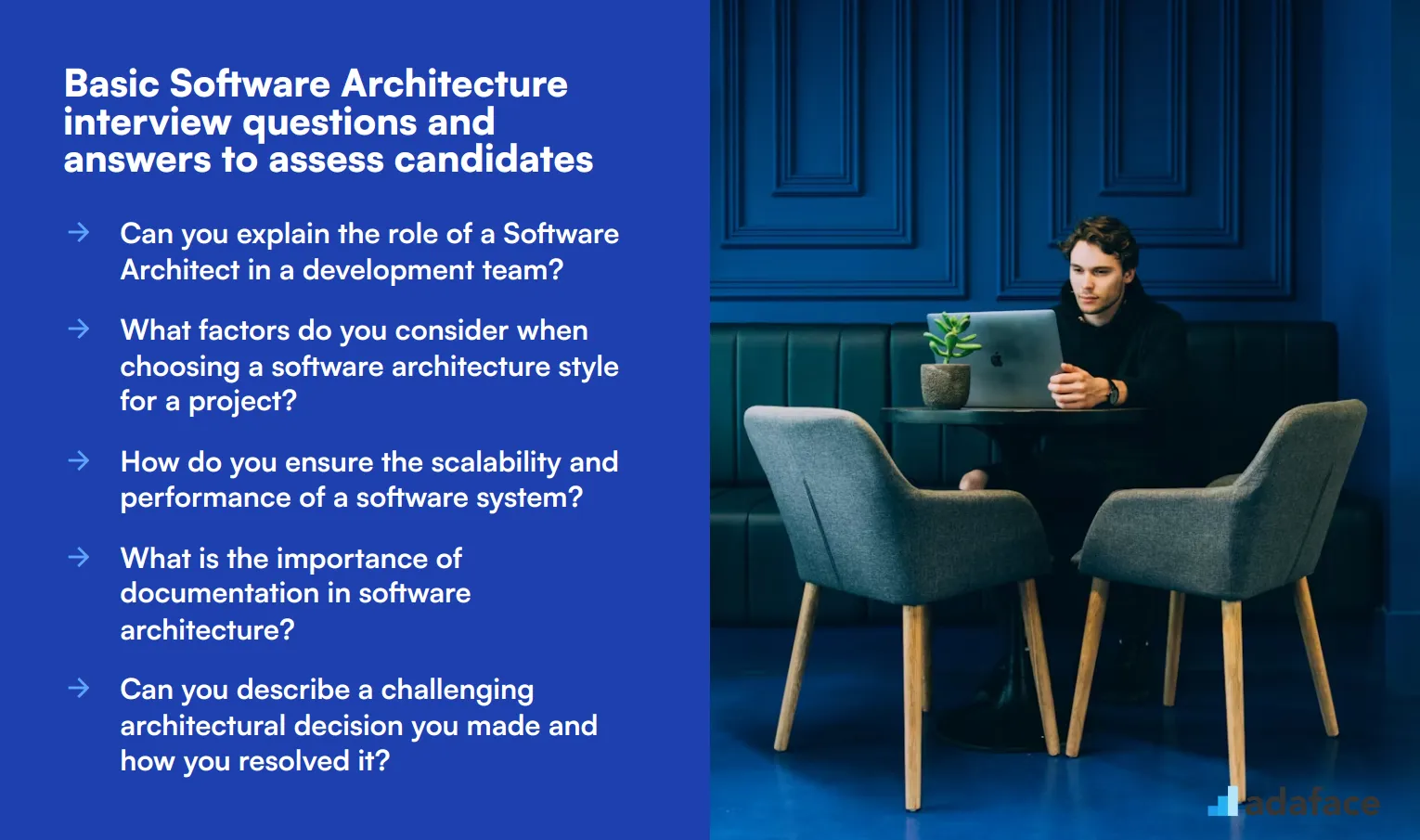
Whether you're a recruiter or a hiring manager, these 10 basic Software Architecture interview questions are a great starting point to assess your candidates' understanding and approach. These questions will help you gauge their ability to think critically and solve problems, ensuring they are well-suited for the role.
1. Can you explain the role of a Software Architect in a development team?
A Software Architect is responsible for designing the high-level structure of software systems. They make critical decisions about the architecture and oversee the technical standards, including coding standards, tools, and platforms.
These professionals also collaborate with stakeholders to ensure the architecture aligns with business goals and requirements. They often mentor and guide the development team to ensure the architecture is implemented correctly.
An ideal candidate should demonstrate a clear understanding of these responsibilities and provide examples of how they have successfully fulfilled this role in the past.
2. What factors do you consider when choosing a software architecture style for a project?
Choosing a software architecture style involves considering factors such as the project's requirements, scalability, maintainability, and performance. Common styles include monolithic, microservices, and event-driven architectures.
Candidates should also mention the importance of understanding the team's expertise and the technology stack available. They may also discuss the need for future-proofing and flexibility to adapt to changing requirements.
Look for candidates who can articulate a well-rounded approach and provide examples of different architecture styles they have implemented in past projects.
3. How do you ensure the scalability and performance of a software system?
Ensuring scalability and performance involves both proactive planning and continuous monitoring. Key strategies include load balancing, using efficient algorithms, and optimizing database queries.
Candidates should also mention the importance of conducting performance testing and monitoring system metrics to identify bottlenecks. They might discuss tools and techniques they use for performance profiling and optimization.
Strong responses will include specific examples of how the candidate has addressed scalability and performance challenges in the past.
4. What is the importance of documentation in software architecture?
Documentation is crucial in software architecture as it provides a reference for the development team and stakeholders. It ensures that everyone understands the architecture, design decisions, and how different components interact.
Good documentation can also facilitate onboarding new team members and maintaining the system over time. It includes architectural diagrams, decision logs, and technical specifications.
Look for candidates who emphasize the importance of clear, concise, and up-to-date documentation and who can provide examples of how they have created and used documentation in previous projects.
5. Can you describe a challenging architectural decision you made and how you resolved it?
A candidate might discuss a situation where they had to choose between different architectural patterns or tools. They should describe the problem, the options considered, and the criteria used to make the decision.
They should also explain the outcome of their decision and any lessons learned from the experience. This demonstrates their ability to analyze complex situations and make informed choices.
An ideal answer will include specific details and show the candidate's thought process and problem-solving skills.
6. How do you stay updated with the latest trends and technologies in software architecture?
Staying updated involves continuous learning through various channels such as industry conferences, online courses, and reading technical blogs and journals. Active participation in professional communities and forums is also beneficial.
Candidates might also mention the importance of hands-on practice with new tools and technologies to understand their practical applications. They should be able to provide examples of recent trends they are following.
Look for candidates who demonstrate a proactive approach to learning and can discuss recent advancements in the field.
7. What role does security play in software architecture?
Security is a fundamental aspect of software architecture. It involves designing systems that protect data and resources from unauthorized access and vulnerabilities.
Candidates should discuss practices such as threat modeling, implementing security patterns, and regular security audits. They might also mention the importance of adhering to compliance standards and regulations.
Strong responses will include specific security measures the candidate has implemented in past projects and their approach to staying updated with security best practices.
8. How do you approach technical debt in a project?
Technical debt refers to the compromises made in a codebase to meet deadlines or constraints, which can impact long-term maintainability. Managing technical debt involves identifying, prioritizing, and addressing these issues systematically.
Candidates should discuss strategies such as regular code reviews, refactoring, and balancing short-term and long-term goals. They might also mention tools and metrics they use to track technical debt.
Look for candidates who can provide examples of how they have successfully managed and reduced technical debt in previous projects.
9. What is your experience with cloud architecture, and what are the key considerations?
Cloud architecture involves designing systems that leverage cloud services for scalability, flexibility, and cost-efficiency. Key considerations include choosing the right cloud provider, understanding service offerings, and designing for redundancy and failover.
Candidates should also mention the importance of security, compliance, and cost management in cloud environments. They might discuss specific cloud architectures they have implemented, such as microservices or serverless.
An ideal response will include examples of the candidate's experience with cloud architecture and their approach to addressing common challenges.
10. How do you handle disagreements within the development team about architectural decisions?
Handling disagreements involves effective communication and collaboration. It's important to listen to all perspectives, facilitate open discussions, and base decisions on data and objective criteria.
Candidates should mention techniques such as conducting technical reviews, using architectural principles as guidelines, and seeking input from stakeholders. They might also discuss the importance of fostering a culture of respect and trust.
Look for candidates who can provide examples of how they have navigated disagreements and reached consensus in previous projects.
20 Software Architecture interview questions to ask junior architects
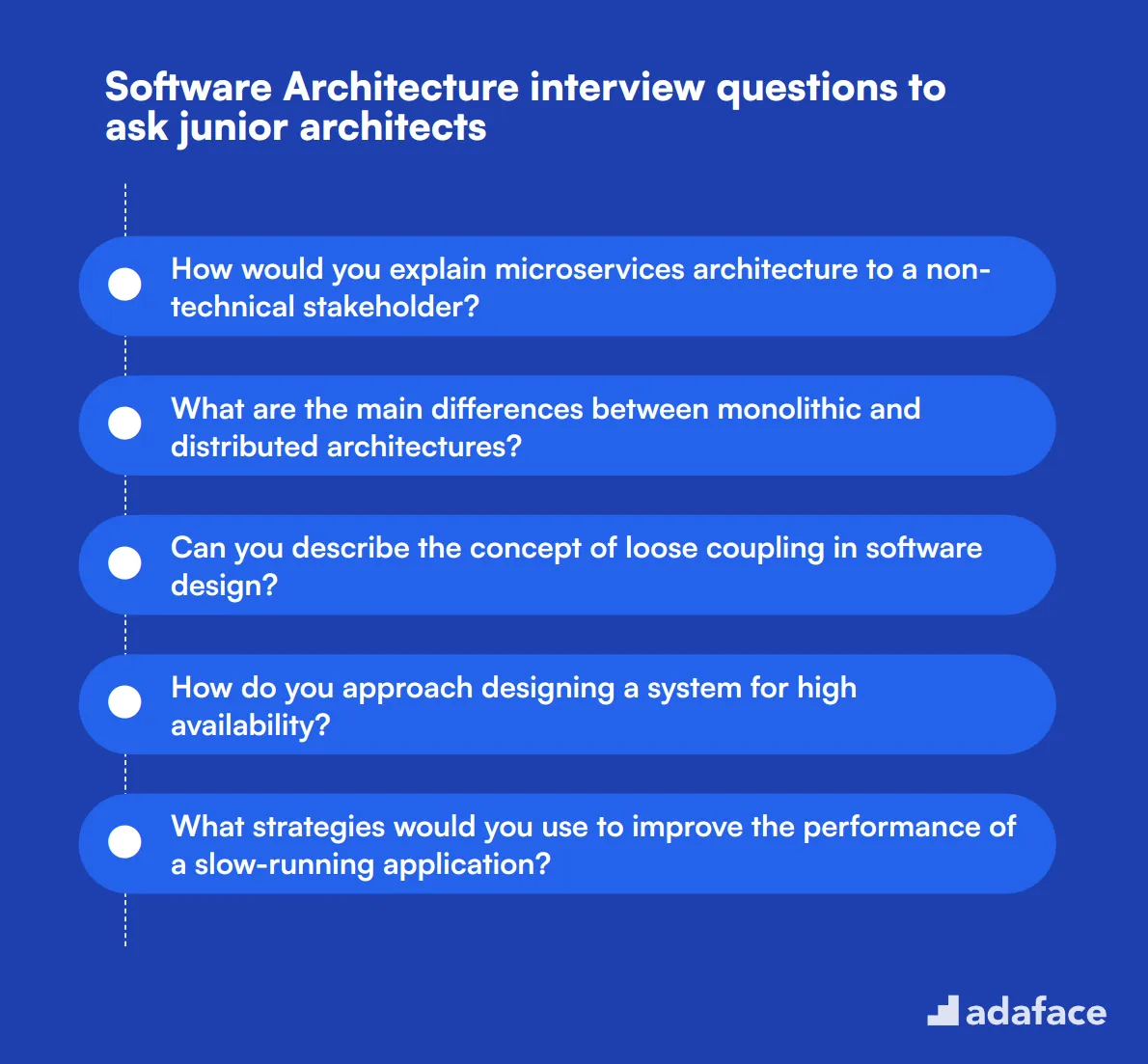
When interviewing junior software architects, it's crucial to assess their foundational knowledge and problem-solving skills. Use these 20 questions to gauge their understanding of key concepts and their ability to apply architectural principles in real-world scenarios.
- How would you explain microservices architecture to a non-technical stakeholder?
- What are the main differences between monolithic and distributed architectures?
- Can you describe the concept of loose coupling in software design?
- How do you approach designing a system for high availability?
- What strategies would you use to improve the performance of a slow-running application?
- How do you ensure data consistency in a distributed system?
- What are the key principles of RESTful API design?
- How would you architect a system to handle sudden traffic spikes?
- Can you explain the concept of eventual consistency in distributed systems?
- What are the main considerations when designing a multi-tenant architecture?
- How do you approach database sharding in a large-scale application?
- What are the pros and cons of using a message queue in system design?
- How would you design a caching strategy for a web application?
- Can you explain the concept of idempotency in API design?
- What are the key differences between SOAP and REST APIs?
- How do you ensure backward compatibility when evolving an API?
- What are the main challenges in designing a microservices architecture?
- How would you approach designing a system for real-time data processing?
- Can you explain the concept of eventual consistency in distributed systems?
- What are the key considerations when designing for cloud-native applications?
10 intermediate Software Architecture interview questions and answers to ask mid-tier architects
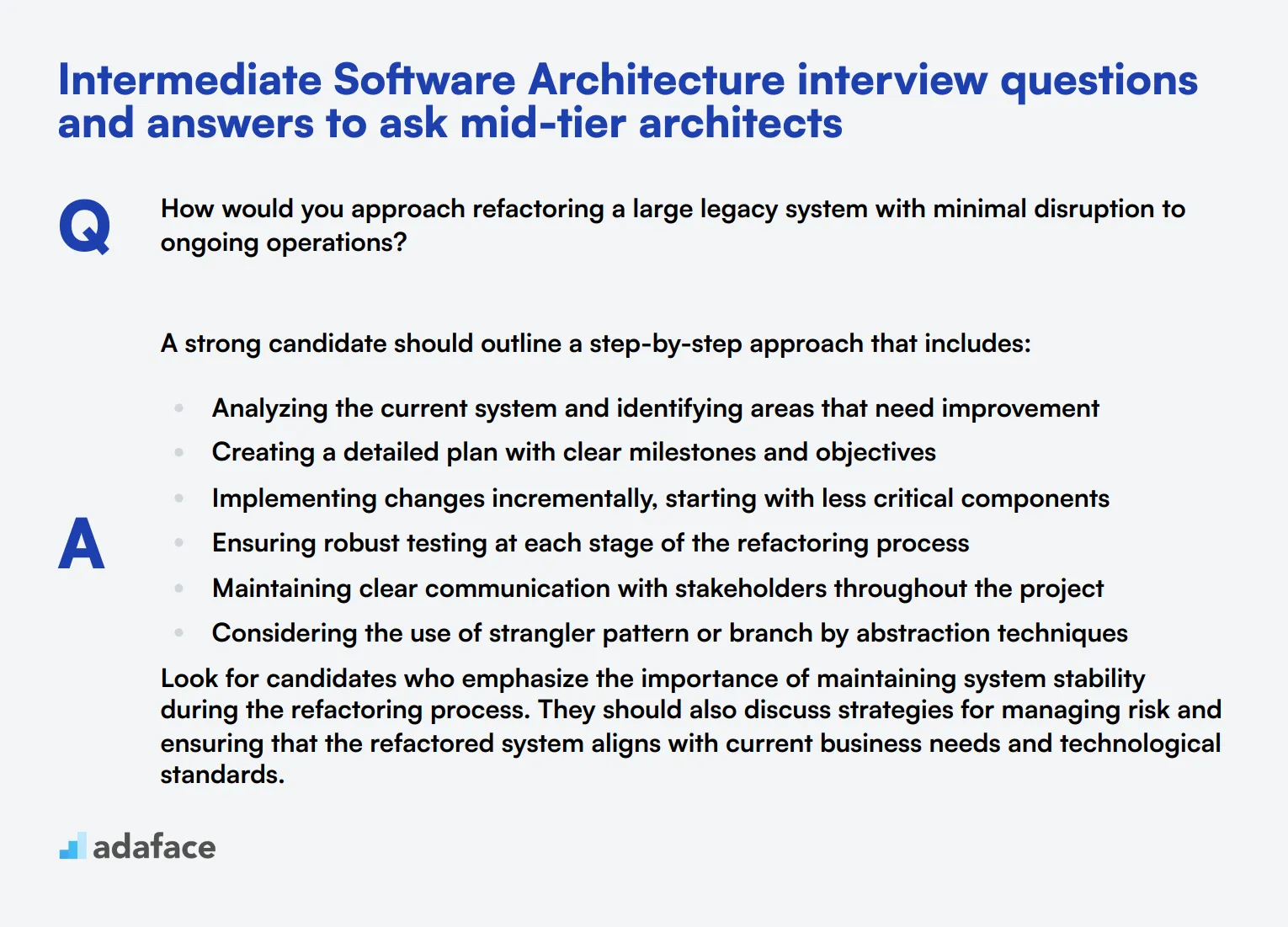
Ready to level up your software architecture interviews? These 10 intermediate questions are perfect for assessing mid-tier architects. They'll help you gauge a candidate's understanding of complex systems, design principles, and problem-solving skills. Use these questions to dive deeper into a candidate's architectural thinking and see how they approach real-world challenges.
1. How would you approach refactoring a large legacy system with minimal disruption to ongoing operations?
A strong candidate should outline a step-by-step approach that includes:
- Analyzing the current system and identifying areas that need improvement
- Creating a detailed plan with clear milestones and objectives
- Implementing changes incrementally, starting with less critical components
- Ensuring robust testing at each stage of the refactoring process
- Maintaining clear communication with stakeholders throughout the project
- Considering the use of strangler pattern or branch by abstraction techniques
Look for candidates who emphasize the importance of maintaining system stability during the refactoring process. They should also discuss strategies for managing risk and ensuring that the refactored system aligns with current business needs and technological standards.
2. Can you explain the concept of Domain-Driven Design (DDD) and how it relates to software architecture?
Domain-Driven Design is an approach to software development that focuses on creating a shared understanding of the problem domain between technical and non-technical stakeholders. It emphasizes aligning the software model with the business domain.
Key concepts of DDD include:
- Ubiquitous Language: A common vocabulary used by all team members
- Bounded Contexts: Clearly defined boundaries for different domain models
- Aggregates: Clusters of domain objects treated as a single unit
- Domain Events: Significant occurrences within the domain
- Context Mapping: Strategies for integrating different bounded contexts
A strong candidate should be able to explain how DDD influences architectural decisions, such as service boundaries in microservices architectures or module organization in monolithic systems. They should also discuss the benefits of DDD in creating more maintainable and business-aligned software systems.
3. How do you ensure that a system's architecture can evolve over time without accumulating technical debt?
A comprehensive answer should include strategies such as:
- Implementing a modular architecture with clear separation of concerns
- Adhering to SOLID principles and other best practices in software design
- Regularly refactoring code to improve its structure and readability
- Maintaining comprehensive automated test suites to catch regressions
- Conducting periodic architecture reviews and assessments
- Encouraging continuous learning and knowledge sharing within the team
- Balancing short-term needs with long-term architectural goals
Look for candidates who emphasize the importance of proactive measures and continuous improvement. They should demonstrate an understanding of how architectural decisions impact long-term maintainability and software security. A strong answer might also include examples of how they've successfully managed technical debt in previous projects.
4. Explain the concept of event sourcing and its potential benefits and drawbacks in system design.
Event sourcing is an architectural pattern where the state of a system is determined by a sequence of events rather than just the current state. Each change to the system is captured as an event and stored in an append-only event log.
Benefits of event sourcing include:
- Complete audit trail and history of all changes
- Ability to reconstruct the system state at any point in time
- Improved scalability and performance in certain scenarios
- Easier implementation of complex business logic and temporal queries
Drawbacks may include:
- Increased complexity in system design and implementation
- Potential performance issues when replaying a large number of events
- Challenges in data migration and schema evolution
- Learning curve for developers unfamiliar with the pattern
A strong candidate should be able to discuss scenarios where event sourcing is particularly beneficial, such as in financial systems or applications requiring detailed audit trails. They should also demonstrate an understanding of how event sourcing relates to other patterns like CQRS (Command Query Responsibility Segregation) and its impact on system scalability and consistency.
5. How would you design a system to handle unpredictable spikes in user traffic?
A comprehensive answer should include strategies such as:
- Implementing auto-scaling mechanisms to dynamically adjust resources
- Utilizing load balancers to distribute traffic evenly across multiple servers
- Employing caching strategies to reduce database load
- Implementing asynchronous processing for non-critical tasks
- Using content delivery networks (CDNs) for static content
- Designing with microservices architecture for better scalability
- Implementing rate limiting and throttling mechanisms
- Considering serverless architectures for certain components
Look for candidates who emphasize the importance of monitoring and alerting systems to detect and respond to traffic spikes quickly. They should also discuss the trade-offs between different scaling strategies and the importance of load testing to validate the system's performance under stress. A strong answer might include examples of how they've handled similar challenges in previous projects.
6. What strategies would you employ to ensure data consistency in a distributed microservices architecture?
Ensuring data consistency in a distributed microservices architecture is challenging due to the decentralized nature of the system. Some strategies to address this include:
- Implementing the Saga pattern for managing distributed transactions
- Using event-driven architecture to propagate changes across services
- Employing the Outbox pattern to ensure reliable message publishing
- Implementing eventual consistency where appropriate
- Using distributed caching mechanisms to improve data access performance
- Implementing compensating transactions for rollback scenarios
- Utilizing a service mesh for improved communication and consistency between services
A strong candidate should be able to discuss the trade-offs between strong consistency and eventual consistency, and when each is appropriate. They should also demonstrate an understanding of the challenges posed by network partitions and how to design systems that are resilient to such failures. Look for answers that show a deep understanding of distributed systems principles and practical experience in implementing these strategies.
7. How would you approach designing a system for multi-region deployment with low latency requirements?
Designing a system for multi-region deployment with low latency requires careful consideration of data distribution, replication, and routing. Key strategies include:
- Implementing a geographically distributed database with multi-region replication
- Utilizing Content Delivery Networks (CDNs) for static content
- Employing edge computing for processing closer to the user
- Implementing intelligent routing to direct users to the nearest data center
- Using caching strategies at various levels (browser, CDN, application, database)
- Optimizing network protocols and using techniques like connection pooling
- Implementing asynchronous processing where possible to reduce perceived latency
- Considering eventual consistency models for non-critical data
Look for candidates who discuss the challenges of maintaining data consistency across regions and strategies to mitigate these issues. They should also demonstrate an understanding of the trade-offs between latency, consistency, and cost in multi-region deployments. A strong answer might include examples of tools and technologies they've used for monitoring and optimizing multi-region systems.
8. Explain the concept of chaos engineering and how it can be applied to improve system resilience.
Chaos engineering is the practice of intentionally introducing controlled failures and disruptions into a system to test its resilience and identify weaknesses. It involves running experiments in production environments to build confidence in the system's ability to withstand turbulent conditions.
Key principles of chaos engineering include:
- Defining the system's 'steady state' behavior
- Hypothesizing about the steady state during a disruption
- Designing experiments to introduce real-world failures
- Running experiments in production
- Automating experiments to run continuously
Common chaos experiments might include:
- Simulating the failure of a service or database
- Introducing network latency or packet loss
- Overloading system resources (CPU, memory, disk)
- Forcing the system to switch to backup data centers
A strong candidate should be able to discuss the benefits of chaos engineering, such as improved system reliability and reduced incident response times. They should also emphasize the importance of having a robust monitoring and observability infrastructure in place before conducting chaos experiments. Look for answers that demonstrate an understanding of how to safely introduce chaos into systems without causing unnecessary disruption to users.
9. How would you design a system to handle both real-time and batch processing of large datasets?
Designing a system to handle both real-time and batch processing requires a careful balance of technologies and architectural patterns. A comprehensive approach might include:
- Implementing a Lambda architecture with separate paths for batch and stream processing
- Using a message queue or streaming platform (e.g., Apache Kafka) for ingesting real-time data
- Employing a distributed processing framework (e.g., Apache Spark) for batch processing
- Implementing a serving layer that combines results from both batch and real-time processing
- Utilizing a data lake for storing raw data that can be processed by both paths
- Implementing a unified view layer to present consistent results to end-users
- Considering a Kappa architecture for scenarios where the same processing logic can be applied to both batch and streaming data
Look for candidates who can discuss the trade-offs between different architectural approaches and their suitability for various use cases. They should demonstrate an understanding of the challenges in maintaining consistency between batch and real-time results, and strategies to address these challenges. A strong answer might also include considerations for data governance, schema evolution, and system scalability.
10. How do you approach designing a system for high availability across multiple data centers?
Designing for high availability across multiple data centers involves several key strategies:
- Implementing active-active or active-passive replication between data centers
- Using global load balancers for intelligent traffic routing
- Employing distributed databases with multi-region support
- Implementing asynchronous replication for non-critical data
- Utilizing content delivery networks (CDNs) for static content distribution
- Implementing circuit breakers and fallback mechanisms
- Designing for graceful degradation of services
- Employing chaos engineering practices to test failover scenarios
A strong candidate should discuss the importance of regular failover testing and disaster recovery drills. They should also address challenges such as data consistency across regions, latency issues, and the cost implications of multi-data center architectures. Look for answers that demonstrate an understanding of the trade-offs between consistency, availability, and partition tolerance (CAP theorem) in distributed systems.
15 advanced Software Architecture interview questions to ask senior architects
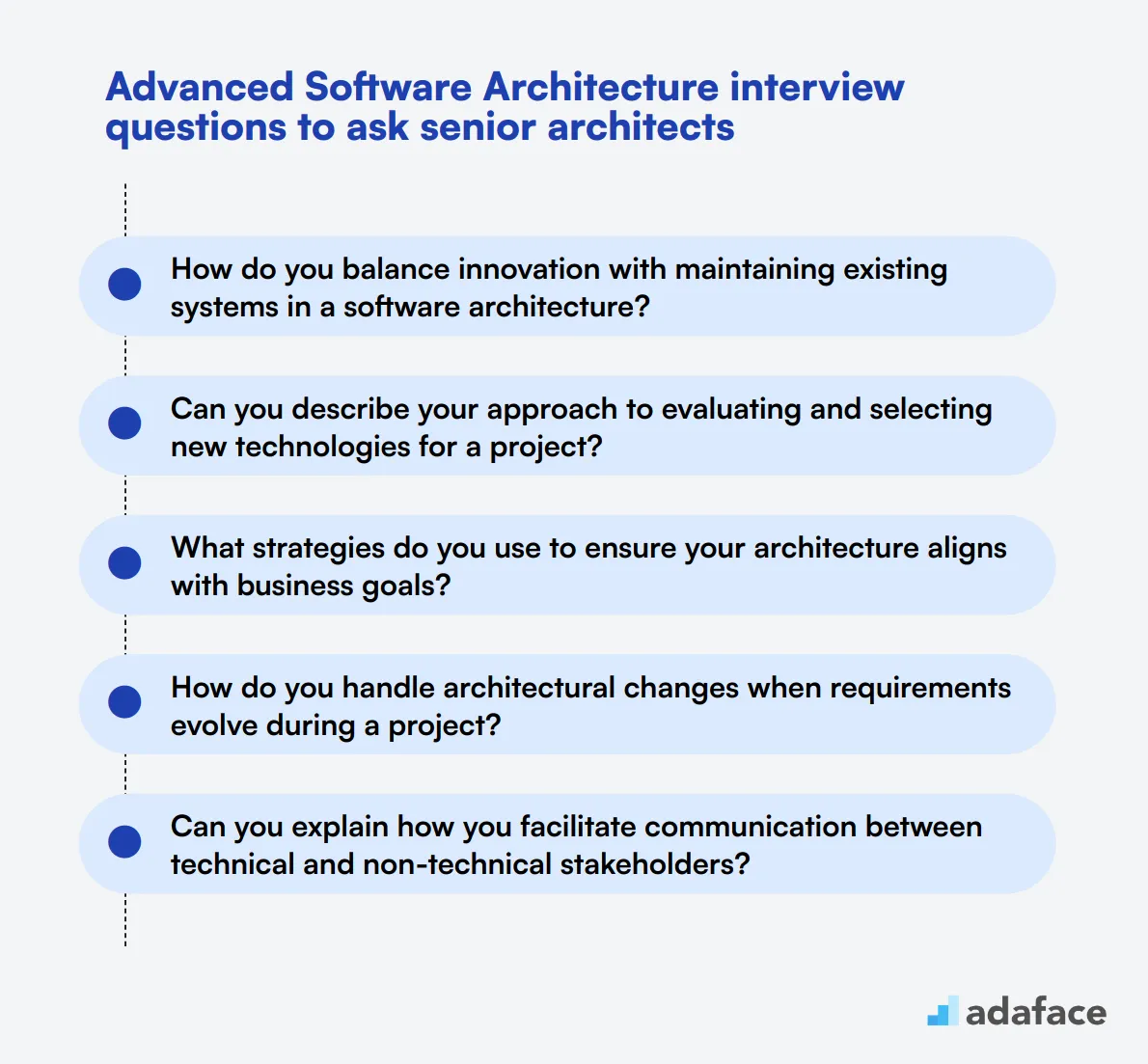
To effectively assess the depth of knowledge and experience of senior software architects, consider using this curated list of advanced questions. These inquiries can reveal not just technical skills but also strategic thinking and problem-solving abilities, making them essential during the interview process for software architect roles.
- How do you balance innovation with maintaining existing systems in a software architecture?
- Can you describe your approach to evaluating and selecting new technologies for a project?
- What strategies do you use to ensure your architecture aligns with business goals?
- How do you handle architectural changes when requirements evolve during a project?
- Can you explain how you facilitate communication between technical and non-technical stakeholders?
- What are the key performance indicators (KPIs) you consider when evaluating an architecture?
- How would you design an architecture that promotes continuous integration and delivery?
- What are some common pitfalls you've encountered in architectural design, and how did you address them?
- How do you approach the integration of legacy systems with new software solutions?
- Can you explain your experience with service mesh architectures and their benefits?
- What considerations do you take into account when designing for compliance and regulatory requirements?
- How would you approach disaster recovery planning in your architecture?
- In your experience, what are the trade-offs between using third-party services versus building in-house solutions?
- How do you manage stakeholder expectations during the architecture design phase?
- Can you share an example of how you applied design patterns in your architectural decisions?
8 Software Architecture interview questions and answers related to design patterns
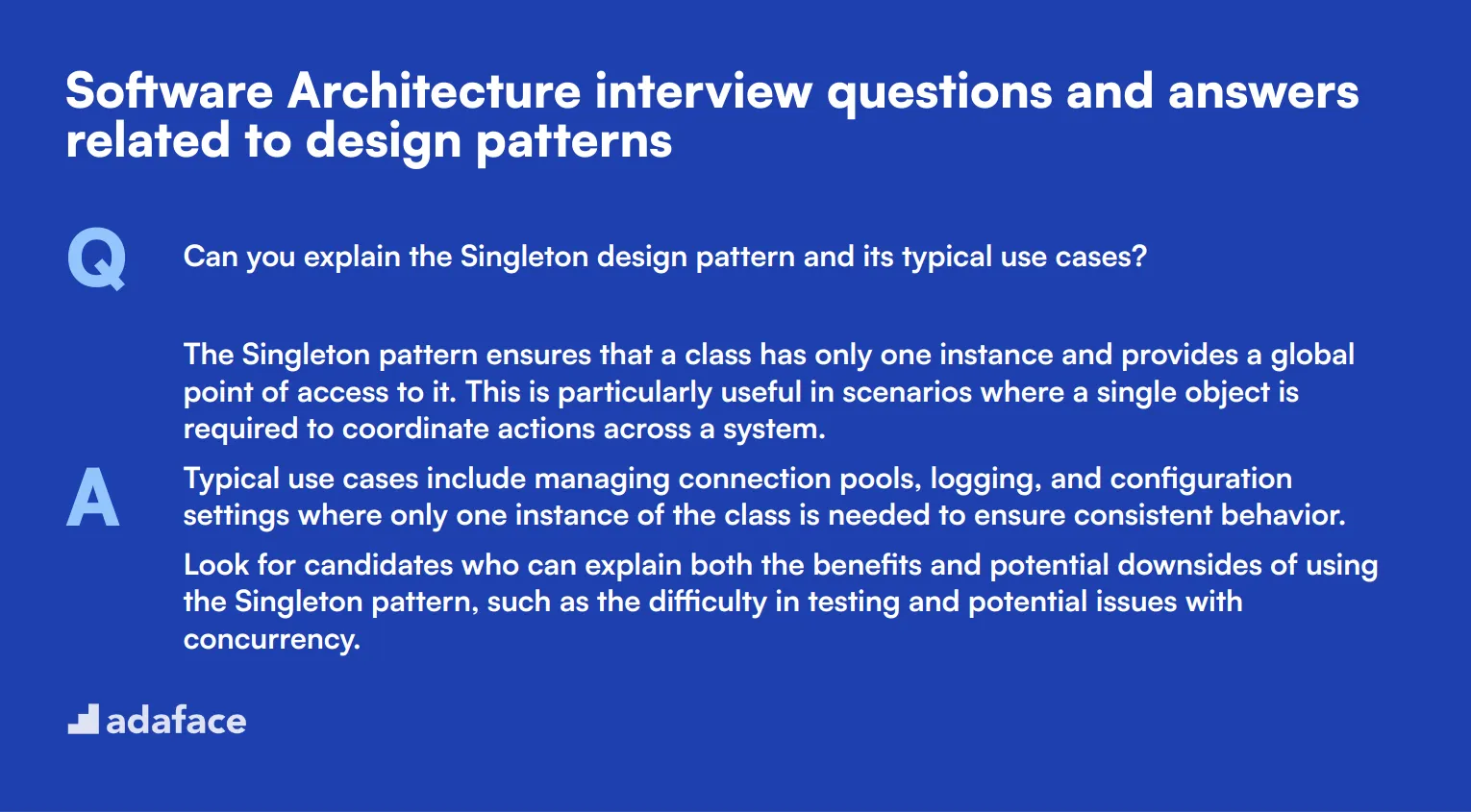
Design patterns are the building blocks of robust and scalable software architecture. To determine whether your candidates have a solid grasp of these essential concepts, consider these interview questions. Perfect for getting insights into their problem-solving abilities and architectural knowledge.
1. Can you explain the Singleton design pattern and its typical use cases?
The Singleton pattern ensures that a class has only one instance and provides a global point of access to it. This is particularly useful in scenarios where a single object is required to coordinate actions across a system.
Typical use cases include managing connection pools, logging, and configuration settings where only one instance of the class is needed to ensure consistent behavior.
Look for candidates who can explain both the benefits and potential downsides of using the Singleton pattern, such as the difficulty in testing and potential issues with concurrency.
2. What is the Factory Method pattern, and when would you use it?
The Factory Method pattern defines an interface for creating an object, but allows subclasses to alter the type of objects that will be created. This pattern promotes loose coupling by eliminating the need to bind application-specific classes into the code.
It's particularly useful when the exact type of the object needs to be determined dynamically at runtime, such as when creating objects whose types are dependent on user input or configuration settings.
A strong candidate will highlight scenarios where the Factory Method pattern can improve flexibility and maintainability in your codebase.
3. Describe the Observer design pattern and provide an example of where it could be used.
The Observer pattern defines a one-to-many dependency between objects so that when one object changes state, all its dependents are notified and updated automatically. This is typically used for event handling systems.
An example use case could be a subscription system where users subscribe to updates on a topic. When new content is available, all subscribed users are notified.
Look for candidates who understand the decoupling benefits of this pattern and can discuss potential pitfalls, such as managing subscriber lists and handling notifications efficiently.
4. Can you explain the Decorator design pattern and its advantages?
The Decorator pattern allows behavior to be added to individual objects, either statically or dynamically, without affecting the behavior of other objects from the same class. This is achieved by creating a set of decorator classes that are used to wrap concrete components.
It is particularly advantageous for adhering to the Single Responsibility Principle as it allows functionalities to be divided between classes with unique areas of concern, leading to more maintainable code.
Candidates should be able to discuss how the Decorator pattern can offer more flexibility than static inheritance and provide examples, such as adding responsibilities to graphical user interface components.
5. What is the Strategy design pattern, and why is it useful?
The Strategy pattern defines a family of algorithms, encapsulates each one, and makes them interchangeable. The strategy pattern lets the algorithm vary independently from clients that use it.
This pattern is useful for scenarios where multiple algorithms or strategies are required for a task, such as different sorting methods or payment methods in an e-commerce system.
When evaluating responses, look for candidates who can articulate the benefits of flexibility and extensibility that the Strategy pattern provides, as well as discuss potential use cases.
6. Explain the Adapter design pattern and its purpose.
The Adapter pattern allows incompatible interfaces to work together by converting the interface of a class into another interface that the clients expect. It essentially acts as a bridge between two incompatible interfaces.
This pattern is particularly beneficial when integrating new components into an existing system or when using third-party libraries that do not match the application's current architecture.
An ideal response will include examples of how the Adapter pattern can simplify integration and enhance reusability, and should also touch on potential drawbacks, such as added complexity.
7. What is the Command design pattern, and how would you implement it?
The Command pattern encapsulates a request as an object, thereby allowing for parameterization of clients with different requests, queuing of requests, and logging of the requests. It also provides support for undoable operations.
A practical implementation could be a text editor where user actions like typing, deleting, or formatting text are encapsulated as command objects that can be undone and redone.
Candidates should be able to discuss the structure of this pattern and potential use cases, as well as highlight the benefits in terms of maintainability and flexibility.
8. Describe the Chain of Responsibility pattern and its potential benefits.
The Chain of Responsibility pattern allows an object to send a command without knowing which object will handle the request. The request is passed along a chain of handlers until an appropriate handler is found.
This pattern is useful in scenarios where multiple objects can handle a request, such as in user interface event handling or in logging systems where different handlers process different types of log messages.
A strong candidate will emphasize the pattern’s ability to decouple the sender and receiver, making the system more flexible and easier to extend.
7 Software Architecture interview questions and answers related to scalability
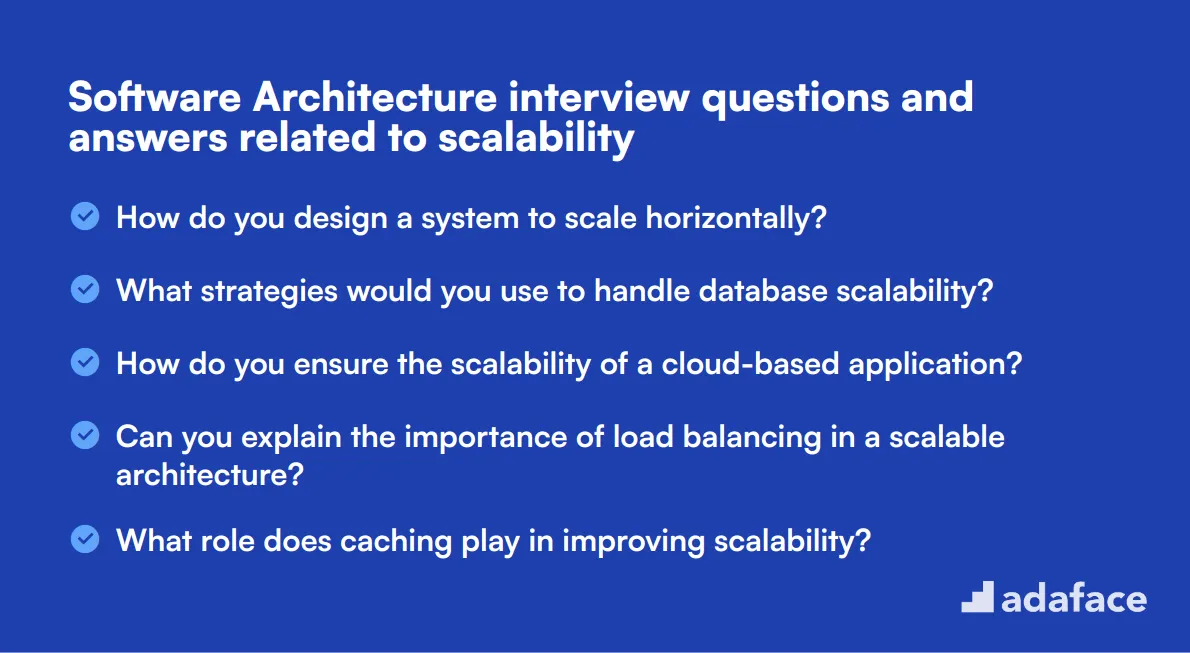
Scalability is a critical aspect of software architecture, ensuring that systems can handle growth efficiently. This list of interview questions and answers will help you identify candidates who understand scalability concepts and can design systems to adapt to increasing demands.
1. How do you design a system to scale horizontally?
Designing a system to scale horizontally typically involves adding more instances of the application or service to distribute the load. This is often achieved through techniques like load balancing, stateless application design, and data partitioning.
Key considerations include ensuring the system is stateless, meaning it does not store user session data on the server itself, and designing a robust load balancing mechanism to distribute incoming requests evenly across multiple instances.
Look for candidates who mention these strategies and can explain their benefits and potential challenges. Follow up with questions about their experience with specific tools or technologies for horizontal scaling.
2. What strategies would you use to handle database scalability?
To handle database scalability, strategies such as database replication, sharding, and using NoSQL databases can be employed. Replication involves creating copies of the database to spread the read load, while sharding splits the database into smaller, more manageable pieces.
Using a NoSQL database can also be beneficial for scalability, as they are designed to handle large volumes of unstructured data and can scale horizontally more easily than traditional relational databases.
Ideal candidates should be able to discuss these strategies in detail, including the pros and cons of each. They might also reference specific cases where they implemented these strategies successfully.
3. How do you ensure the scalability of a cloud-based application?
Ensuring the scalability of a cloud-based application involves leveraging cloud-native features such as auto-scaling, managed databases, and content delivery networks (CDNs). Auto-scaling automatically adjusts the number of instances based on traffic, ensuring resources match demand.
Managed databases take care of underlying infrastructure and can scale seamlessly, while CDNs distribute content closer to users to reduce latency and server load.
Candidates should demonstrate familiarity with these cloud-native features and provide examples of how they have used them in past projects. They should also be able to discuss cost implications and monitoring strategies.
4. Can you explain the importance of load balancing in a scalable architecture?
Load balancing is crucial in a scalable architecture as it ensures that incoming traffic is distributed evenly across multiple servers or instances. This prevents any single server from becoming a bottleneck and improves overall system performance and reliability.
There are various types of load balancers, including hardware-based, software-based, and cloud-based options. Each type has its use cases, and the choice depends on the specific requirements and constraints of the system.
Look for candidates who can explain the different types of load balancers and provide examples of how they have implemented load balancing in their projects. They should also discuss any challenges they encountered and how they addressed them.
5. What role does caching play in improving scalability?
Caching plays a significant role in improving scalability by reducing the load on the database and application servers. By storing frequently accessed data in memory, caching allows for faster retrieval and reduces the need for repeated database queries.
There are different types of caching, such as client-side caching, server-side caching, and distributed caching. Each type has its own advantages and use cases, depending on the system's requirements.
Candidates should be able to explain the benefits of caching and provide examples of how they have implemented caching strategies in their projects. They should also discuss any trade-offs and considerations, such as cache invalidation and consistency.
6. How do you handle state management in a scalable system?
In a scalable system, state management is often handled by maintaining a stateless architecture. This means that the application does not store any user session data on the server, allowing for easy scaling by adding or removing instances without session data loss.
State can be managed using external storage solutions such as databases, distributed caches, or session management services that provide centralized storage for state information.
Candidates should discuss the importance of a stateless architecture and provide examples of how they have implemented state management solutions in their projects. They should also mention any challenges they faced and how they resolved them.
7. What considerations are important when designing APIs for scalability?
When designing APIs for scalability, considerations include versioning, rate limiting, and idempotency. Versioning ensures that changes to the API do not break existing clients, while rate limiting prevents abuse and ensures fair usage of resources.
Idempotency guarantees that repeated requests have the same effect as a single request, which is important for ensuring consistency and reliability in distributed systems.
An ideal candidate should be able to discuss these considerations in detail and provide examples of how they have designed scalable APIs in their projects. They should also mention any tools or frameworks they have used to implement these features.
6 situational Software Architecture interview questions with answers for hiring top architects
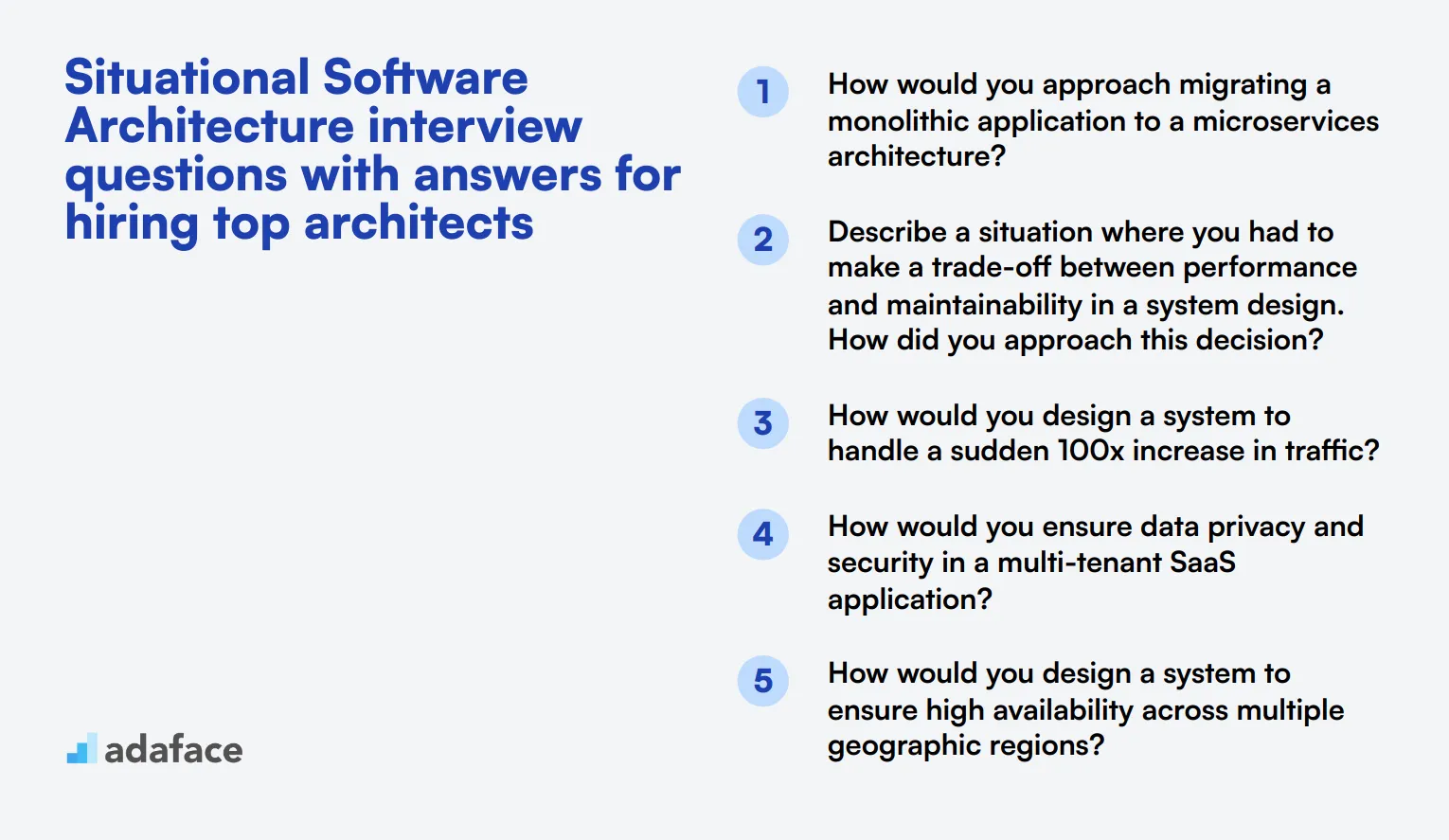
Ready to put your software architect candidates through their paces? These situational interview questions will help you uncover how well they can apply their architectural skills in real-world scenarios. Use these questions to gauge a candidate's problem-solving abilities, technical knowledge, and decision-making prowess in the context of actual software development challenges.
1. How would you approach migrating a monolithic application to a microservices architecture?
A strong candidate should outline a step-by-step approach to this complex task. They might describe a process like this:
- Analyze the existing monolith: Understand its components, dependencies, and data flow.
- Identify bounded contexts: Determine logical boundaries for potential microservices.
- Choose a migration strategy: Such as the strangler pattern or incremental migration.
- Design the new architecture: Plan out the microservices, their interactions, and shared resources.
- Implement and test: Develop and thoroughly test each microservice.
- Deploy and monitor: Gradually replace monolith components with microservices, closely monitoring performance and functionality.
- Refine and optimize: Continuously improve the new architecture based on real-world performance.
Look for candidates who emphasize the importance of careful planning, risk management, and maintaining system stability throughout the migration process. They should also mention strategies for handling data consistency, inter-service communication, and potential challenges like increased operational complexity.
2. Describe a situation where you had to make a trade-off between performance and maintainability in a system design. How did you approach this decision?
An experienced architect should be able to provide a specific example from their past work. They might describe a scenario like optimizing a data processing pipeline or designing a high-traffic web application.
A strong answer would include:
- Clear explanation of the performance vs. maintainability conflict
- Analysis of the pros and cons of each approach
- Consideration of both short-term and long-term impacts
- Involvement of stakeholders in the decision-making process
- The final decision and its rationale
- Results or lessons learned from the decision
Look for candidates who demonstrate a balanced approach to decision-making, considering factors like business requirements, team capabilities, and future scalability. They should show an understanding that there's often no perfect solution, but rather a best fit for the specific context.
3. How would you design a system to handle a sudden 100x increase in traffic?
A competent software architect should outline a multi-faceted approach to handling such a dramatic traffic increase. They might suggest strategies like:
- Implement auto-scaling: Use cloud services to automatically add resources as traffic increases.
- Utilize caching: Implement robust caching mechanisms to reduce database load.
- Content Delivery Networks (CDNs): Distribute static content across global servers.
- Load balancing: Ensure traffic is evenly distributed across available resources.
- Database optimization: Consider read replicas, sharding, or NoSQL solutions for improved performance.
- Asynchronous processing: Use message queues for non-critical tasks to prevent system overload.
- Microservices architecture: Allow independent scaling of system components.
- Performance monitoring and alerting: Implement tools to quickly identify and respond to issues.
Pay attention to candidates who not only list these strategies but also discuss how to implement them with minimal disruption to the existing system. They should also mention the importance of load testing and having a well-defined scaling plan in place before such traffic spikes occur.
4. How would you ensure data privacy and security in a multi-tenant SaaS application?
A knowledgeable architect should provide a comprehensive approach to data privacy and security in a multi-tenant environment. They might outline strategies such as:
- Data isolation: Implement robust database schemas or separate databases for each tenant.
- Encryption: Use strong encryption for data at rest and in transit.
- Access control: Implement fine-grained access controls and role-based authentication.
- Tenant identification: Ensure each request is associated with the correct tenant.
- API security: Use API gateways and implement rate limiting to prevent abuse.
- Regular security audits: Conduct penetration testing and vulnerability assessments.
- Compliance: Ensure the system meets relevant data protection regulations (e.g., GDPR, CCPA).
- Logging and monitoring: Implement comprehensive logging for all data access and changes.
Look for candidates who emphasize the importance of 'security by design' and discuss how these measures would be integrated into the software development lifecycle. They should also mention the need for ongoing employee training and the establishment of clear data handling policies.
5. How would you design a system to ensure high availability across multiple geographic regions?
An experienced architect should outline a strategy that leverages both infrastructure and application design to achieve high availability across regions. They might describe an approach including:
- Multi-region deployment: Distribute the application across multiple geographic regions.
- Data replication: Implement real-time data replication between regions.
- Global load balancing: Use DNS-based or anycast load balancing to route users to the nearest healthy region.
- Asynchronous communication: Design systems to handle temporary regional outages gracefully.
- Caching strategies: Implement distributed caching to reduce latency and increase resilience.
- Disaster recovery planning: Develop and regularly test plans for various failure scenarios.
- Monitoring and alerting: Implement robust monitoring across all regions with automated failover triggers.
- Consistency models: Choose appropriate consistency models (e.g., eventual consistency) to balance availability and data integrity.
Pay attention to candidates who discuss the trade-offs involved in designing for high availability, such as increased complexity and potential impacts on data consistency. They should also mention the importance of considering legal and compliance issues when storing data in multiple geographic locations.
6. How would you approach refactoring a critical legacy system with minimal disruption to ongoing operations?
A skilled architect should present a cautious and methodical approach to refactoring a critical legacy system. They might outline a strategy like:
- System analysis: Thoroughly understand the current system, its dependencies, and pain points.
- Incremental approach: Plan for gradual refactoring rather than a complete rewrite.
- Automated testing: Implement comprehensive automated tests before making changes.
- Parallel running: Develop new components alongside the old system, gradually shifting traffic.
- Feature flags: Use feature toggles to easily enable/disable new functionality.
- Continuous integration and deployment: Implement CI/CD for faster, more reliable updates.
- Monitoring and rollback plans: Have robust monitoring in place and clear procedures for rolling back changes if issues arise.
- Stakeholder communication: Keep all stakeholders informed about the refactoring process and potential impacts.
Look for candidates who emphasize the importance of maintaining system stability throughout the refactoring process. They should discuss strategies for managing risk, such as starting with less critical components and gradually working towards core functionality. A good answer will also touch on the importance of documenting the legacy system and the refactoring process.
Which Software Architecture skills should you evaluate during the interview phase?
While it's challenging to assess every aspect of a candidate's abilities in a single interview, focusing on key Software Architecture skills is crucial. The following core competencies are particularly important to evaluate during the interview process for Software Architect roles.
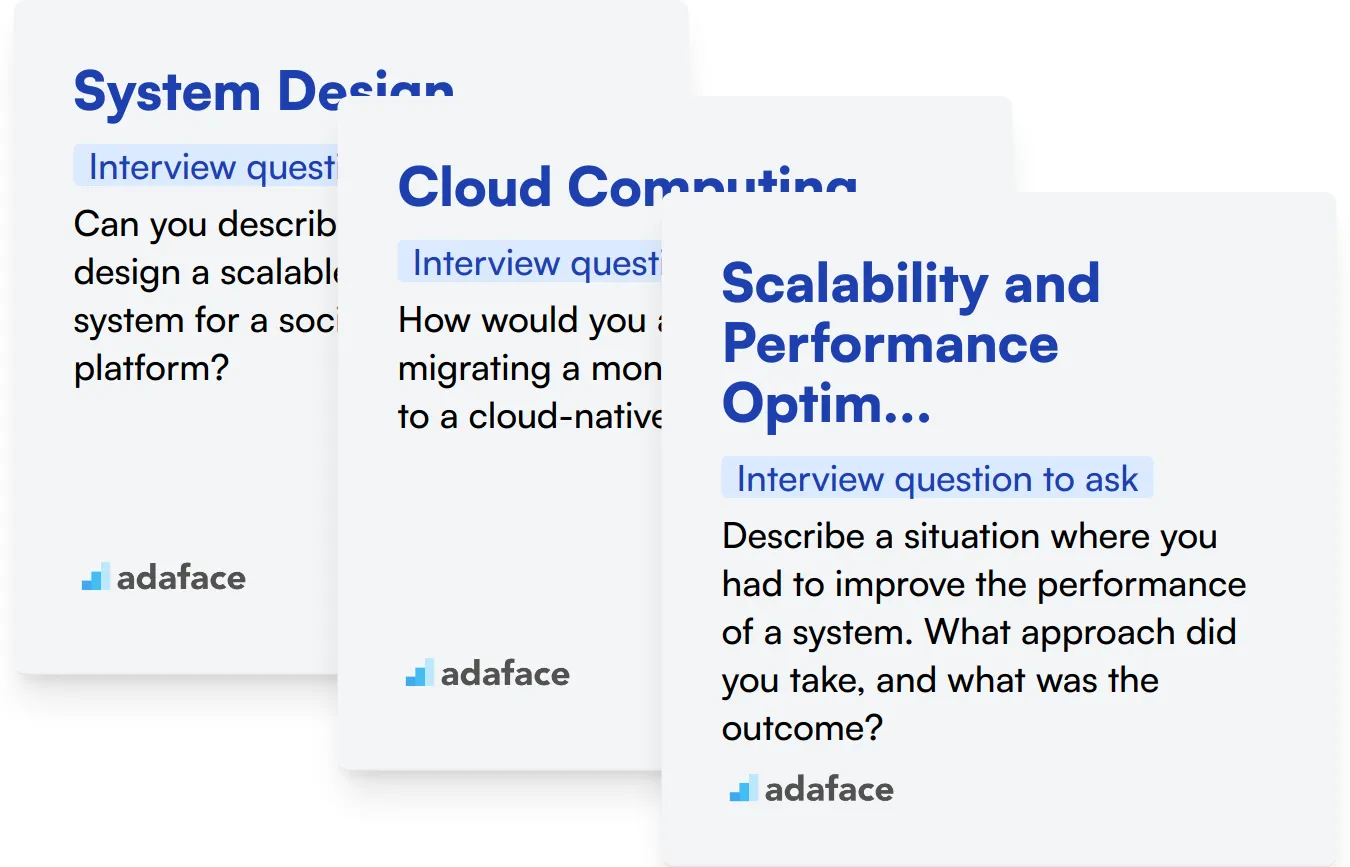
System Design
System design is a fundamental skill for Software Architects. It involves creating high-level solutions to complex problems, considering scalability, performance, and maintainability.
To assess system design skills, consider using an assessment test with relevant MCQs. This can help filter candidates based on their understanding of architectural principles and design patterns.
During the interview, ask targeted questions to gauge the candidate's system design abilities. Here's an example:
Can you describe how you would design a scalable, distributed system for a social media platform?
Look for answers that demonstrate understanding of microservices architecture, load balancing, caching strategies, and database scaling. The candidate should also consider factors like fault tolerance and data consistency.
Cloud Computing
Cloud computing knowledge is increasingly important for Software Architects. It enables efficient resource management, scalability, and cost-effective solutions for modern applications.
To evaluate cloud computing skills, you can use an online assessment that covers various cloud platforms and concepts. This helps identify candidates with a solid foundation in cloud technologies.
During the interview, ask specific questions about cloud architecture. For example:
How would you approach migrating a monolithic application to a cloud-native architecture?
Listen for responses that include strategies for breaking down the monolith, containerization, using cloud services, and addressing challenges like data migration and service communication.
Scalability and Performance Optimization
Scalability and performance optimization are critical for creating robust, high-performing systems. Software Architects must be adept at designing solutions that can handle increasing loads and optimize resource usage.
To assess this skill, consider asking a question like:
Describe a situation where you had to improve the performance of a system. What approach did you take, and what was the outcome?
Look for answers that demonstrate analytical thinking, proficiency in identifying bottlenecks, and knowledge of various optimization techniques. The candidate should be able to explain their problem-solving process and the impact of their solutions.
3 Strategic Tips for Implementing Software Architecture Interview Questions
As you prepare to put the insights from this post into action, consider these strategic tips to enhance the effectiveness of your software architecture interviews.
1. Incorporate Skills Assessments Before the Interview
Before inviting candidates for an interview, using skills tests can provide a preliminary assessment of their technical abilities and fit for the role. This pre-screening step ensures that only the most qualified candidates proceed to the interview stage, saving time and resources.
For software architects, consider leveraging assessments like the Software System Design Online Test or the Data Modeling Test. These tests evaluate critical thinking and technical skills pertinent to the role.
Administering these tests early in the hiring process enables you to gauge the practical skills of your prospects effectively. You can then focus the interview questions on areas of interest that the tests highlighted, ensuring a thorough evaluation of each candidate.
2. Select and Tailor Your Interview Questions Carefully
Due to time constraints, it's important to carefully select and tailor interview questions that effectively assess the key skills needed for the software architecture role.
Consider integrating questions from related domains that help uncover a candidate’s broader technical knowledge and problem-solving skills. Including queries from resources like UML Interview Questions or System Design Interview Questions can provide additional depth to your evaluation.
By focusing on relevant and diverse questions, you can better determine a candidate’s capabilities and potential contributions to your projects.
3. Emphasize the Importance of Thoughtful Follow-Up Questions
While initial questions are vital, the follow-up questions you ask can be key in understanding the depth of a candidate’s knowledge and their problem-solving approach.
For example, if a candidate describes a design pattern they used, follow up by asking for specific challenges they encountered using that pattern. This not only reveals their depth of understanding but also their ability to navigate complexities in software architecture.
Hire Top Software Architects with Skill Tests and Interviews
When hiring someone with software architecture skills, it's important to assess their abilities accurately. The most effective way to do this is by using skill tests. Consider using our Software System Design Test or UML Test to evaluate candidates' knowledge and capabilities.
After using these tests to shortlist the best applicants, you can invite them for interviews. To streamline your hiring process and find the right software architect for your team, explore our Online Assessment Platform. It offers a range of tools to help you make informed hiring decisions.
System Design Online Test
Download Software Architecture interview questions template in multiple formats
Software Architecture Interview Questions FAQs
Common questions include assessing knowledge of design patterns, scalability, and situational problem-solving.
Focus on their understanding of basic concepts and their ability to apply them to simple scenarios.
Ask about advanced topics like system integration, microservices architecture, and strategic design decisions.
Design patterns help you understand the candidate's ability to solve common problems in software design effectively.
They reveal how a candidate thinks on their feet and applies their knowledge to real-world scenarios.
Scalability ensures that a system can handle growth, which is crucial for long-term success and performance.

40 min skill tests.
No trick questions.
Accurate shortlisting.
We make it easy for you to find the best candidates in your pipeline with a 40 min skills test.
Try for freeRelated posts
Free resources




